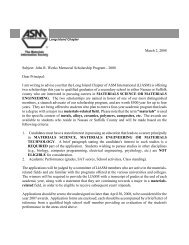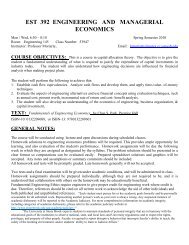ESM 335 Strength of Materials - Materials Science and Engineering
ESM 335 Strength of Materials - Materials Science and Engineering
ESM 335 Strength of Materials - Materials Science and Engineering
You also want an ePaper? Increase the reach of your titles
YUMPU automatically turns print PDFs into web optimized ePapers that Google loves.
<strong>ESM</strong> <strong>335</strong> STRENGTH OF MATERIALS<br />
Class times:<br />
5.20 pm to 6.40 pm (Tuesday, Thursday)<br />
Course description: This course develops a fundamental underst<strong>and</strong>ing <strong>of</strong> the mechanical<br />
behavior <strong>of</strong> materials. Basic concepts in materials <strong>and</strong> mechanics such as<br />
defect structures, elasticity, plasticity <strong>and</strong> fracture are introduced <strong>and</strong><br />
particular emphasis is placed on the materials <strong>and</strong> mechanics issues<br />
associated with fatigue <strong>and</strong> high temperature deformation <strong>of</strong> materials.<br />
Total life <strong>and</strong> damage tolerant approaches to fatigue are invoked to<br />
underst<strong>and</strong> fatigue crack initiation, fatigue crack propagation <strong>and</strong> micromechanisms<br />
<strong>of</strong> fatigue damage. Advanced topics include smart materials.<br />
Pre/Co- requisite(s): AMS 261 Applied Calculus III or MAT203 Calculus III with<br />
Applications; ESG 302 Thermodynamics.<br />
References:<br />
Course objectives:<br />
Course topics:<br />
R. E. Reed-Hill <strong>and</strong> R. Abbaschian – Physical Metallurgy Principles,<br />
Third Edition, Thomas <strong>Engineering</strong>, 1991.<br />
T. L. Anderson, Fracture Mechanics – Fundamentals <strong>and</strong> Applications,<br />
Second Edition, CRC Press, 1995.<br />
N. Dowling, Mechanical Behavior <strong>of</strong> <strong>Materials</strong>, Second Edition, Prentice<br />
Hall, 1999.<br />
S. Suresh, Fatigue <strong>of</strong> <strong>Materials</strong>, Second Edition, Cambridge University<br />
Press, 2003.<br />
W. D. Callister, Jr., <strong>Materials</strong> <strong>Science</strong> <strong>and</strong> <strong>Engineering</strong> – An Introduction,<br />
Sixth Edition, John Wiley <strong>and</strong> Sons, 2003.<br />
1. Obtain familiarity with basic concepts <strong>of</strong> materials science, continuum<br />
mechanics <strong>and</strong> fracture mechanics.<br />
2. Underst<strong>and</strong> basic mechanisms <strong>of</strong> cyclic deformation <strong>and</strong> high<br />
temperature deformation in solids.<br />
3. Identify fatigue crack initiation <strong>and</strong> damage progression processes.<br />
4. Develop quantitative methods for life prediction using damage tolerant<br />
approach to fatigue crack propagation.<br />
<strong>Materials</strong> <strong>Science</strong>; Continuum Mechanics; Fracture Mechanics; Cyclic<br />
Deformation in Solids; Fatigue Crack Initiation; Total Life Approach<br />
Damage Tolerant Approach; Smart <strong>Materials</strong><br />
Contribution <strong>of</strong> Course to meet requirement <strong>of</strong> Criterion 5:<br />
20% <strong>Engineering</strong> <strong>Science</strong>, Mathematics 30%, Basic <strong>Science</strong> 30%, General<br />
Education 20%<br />
Relationship <strong>of</strong> course to program outcomes:
This course studied problems (through home works <strong>and</strong> exams) that were designed to<br />
quantitatively predict <strong>and</strong> underst<strong>and</strong> failure in engineering structures such as bridges or<br />
airplanes <strong>and</strong> met the following program outcomes.<br />
an ability to apply knowledge <strong>of</strong> mathematics, science <strong>and</strong> engineering<br />
an ability to identify, formulate, <strong>and</strong> solve engineering problems<br />
an underst<strong>and</strong>ing <strong>of</strong> pr<strong>of</strong>essional <strong>and</strong> ethical responsibility<br />
the broad education necessary to underst<strong>and</strong> the impact <strong>of</strong> engineering solutions in a<br />
global, economic, environmental <strong>and</strong> societal context<br />
a recognition <strong>of</strong> the need for, <strong>and</strong> an ability to, engage in life-long learning<br />
a knowledge <strong>of</strong> contemporary issues<br />
an ability to use the techniques, skills, <strong>and</strong> modern engineering tools necessary for<br />
engineering practice<br />
Person(s) who prepared this description <strong>and</strong> date <strong>of</strong> preparation: T. A. Venkatesh, 06/23/09.







